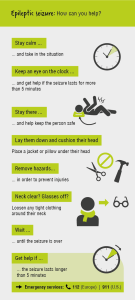Seizures can be caused by various factors, including:

1. Epilepsy: Epilepsy is a neurological disorder characterized by recurrent, unprovoked seizures. It is the most common cause of seizures, but not all seizures are due to epilepsy.
2. Brain Injury or Trauma: Head injuries, traumatic brain injuries (TBI), strokes, brain tumors, and other forms of brain damage can increase the risk of seizures.
3. Genetics: Some types of seizures have a genetic component, meaning they can run in families.
4. Infections: Infections such as meningitis, encephalitis, and HIV/AIDS can trigger seizures.
5. Metabolic Imbalances: Imbalances in electrolytes (such as sodium, potassium, calcium), glucose levels, or other metabolic disturbances can lead to seizures.
6. Withdrawal from Drugs or Alcohol: Abrupt withdrawal from certain medications, drugs, or alcohol can cause seizures.
7. Fever (Febrile Seizures): Febrile seizures, which occur in young children during high fevers, are usually harmless but can be alarming.
8. Sleep Deprivation or Stress: Lack of sleep, high levels of stress, or other triggers can increase susceptibility to seizures in some individuals.
9. Other Medical Conditions: Certain medical conditions such as cerebral palsy, Alzheimer’s disease, and multiple sclerosis may be associated with an increased risk of seizures.
It’s important to consult with a healthcare professional if you or someone you know experiences seizures, as the underlying cause needs to be identified and treated appropriately. Treatment options may include medication, lifestyle changes, or other interventions depending on the individual’s specific condition and circumstances.
First AID to seizure
If you witness someone having a seizure, it’s essential to stay calm and take the following steps to provide first aid:

1. Stay with the Person: Remain with the person having it and keep track of the duration of the seizure. Stay calm and reassure them that they are not alone.
2. Ensure Safety: Move any nearby objects or furniture that could cause injury during the seizure. Clear the area around the person to prevent accidental harm.
3. Protect the Person’s Head: Gently cushion the person’s head with a soft object, such as a folded jacket or cushion, to prevent head injury.
4. Do Not Restrain: Do not attempt to hold the person down or restrain their movements during the seizure. Allow the seizure to run its course naturally.
5. Do Not Put Anything in their Mouth: Contrary to popular belief, it is not necessary to put anything in the person’s mouth to prevent them from biting their tongue. Doing so can actually cause more harm, such as broken teeth or choking.
6. Position for Recovery: After the seizure ends, gently roll the person onto their side to help keep their airway clear and prevent choking. This position also helps drain any fluids from the mouth.
7. Monitor Breathing: Check the person’s breathing and pulse. If they are not breathing or their breathing is irregular, start CPR if you are trained to do so.
8. Stay Calm and Reassure: Stay with the person and offer reassurance as they recover from the seizure. Be patient and supportive.
9. Seek Medical Help if Necessary: If the seizure lasts longer than five minutes, if the person has difficulty breathing, if they are injured, or if it is their first seizure, call for emergency medical assistance immediately.
10. Stay with the Person Until Fully Recovered: Remain with the person until they are fully conscious and alert. Offer assistance as needed and ensure their safety.
Remember that each seizure is different, and providing support and reassurance can make a significant difference in helping the person feel safe and supported during and after the seizure episode.
Remember that each seizure is different.
